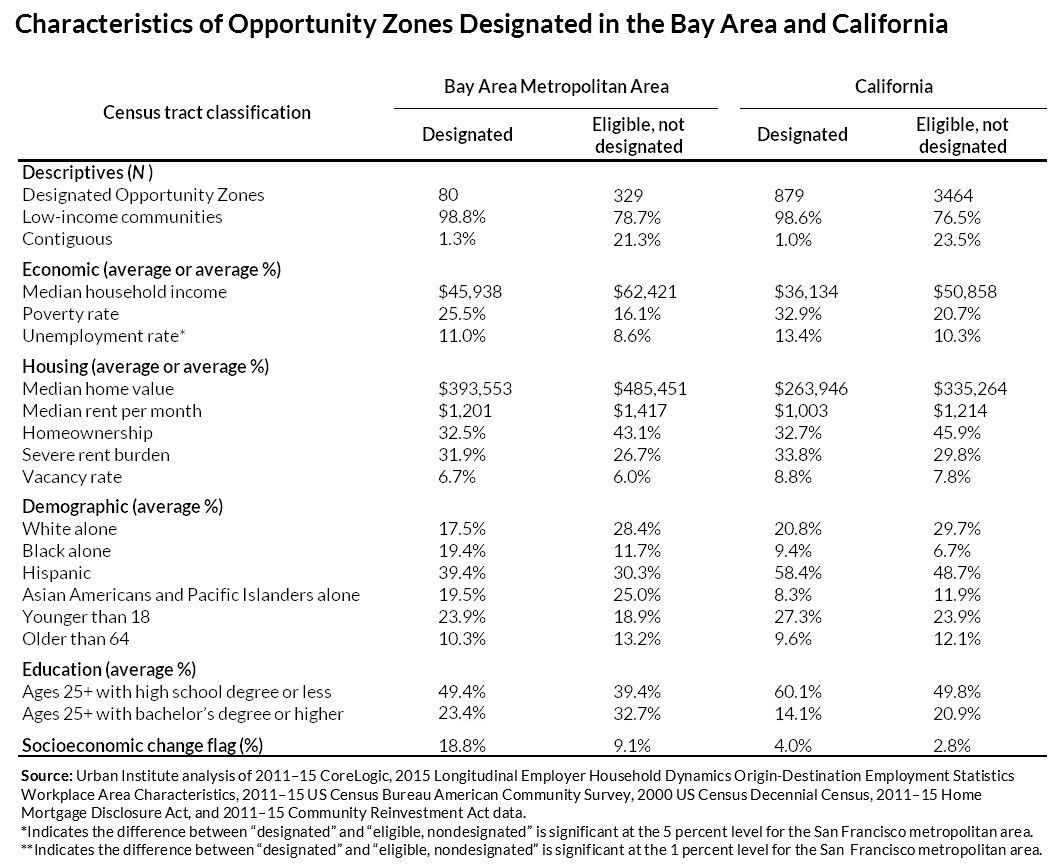
<p>Tourists visit the Golden Gate Bridge in San Francisco, California on December 23, 2017. Photo by Ronen Tivony/Getty Images.</p>
By most measures, the San Francisco metropolitan area is among the nation’s wealthiest. Add Opportunity Zones, what could be the nation’s largest economic development program, and additional economic growth may be in store.
Recently created as part of the Tax Cut and Jobs Act, Opportunity Zones give capital gains tax breaks to corporations and wealthy individuals investing in eligible (usually low-income) areas.
The US Treasury Department recently approved the 879 census tracts in California that Governor Jerry Brown selected to be Opportunity Zones, out of more than 4,300 eligible tracts. Eighty are within the San Francisco metropolitan area. A subset of these tracts are shown in the map below.

To analyze these selections, we compiled two measures—an investment score and a flag for socioeconomic change—to compare designated and nondesignated eligible tracts. Tracts already receiving sizable investments are less likely to need help than those that are not receiving investments. And, given how flexible the incentive is in terms of what projects it supports, selecting gentrifying tracts could exacerbate housing unaffordability and displacement.
We ranked all tracts eligible for designation in the state by current level of commercial, multifamily, single-family, and small-business investment received on a scale from 1 (lowest) to 10 (highest). The table below shows scores for tracts designated as Opportunity Zones in Bay Area.
A quarter of Bay Area zones were among the most disinvested in the state. But several Bay Area zones already receive high levels of investment—nearly 40 percent have an investment score of 8 or higher. In these areas, the new tax benefit might go toward investments that would have occurred without additional incentive.

Gentrification and displacement are significant concerns in Bay Area. To understand how Opportunity Zones relate to this, we created a socioeconomic change measure that flags tracts that experienced substantial change between 2000 and 2016 in share of residents with a bachelor’s degree or higher, median family income, share of non-Hispanic white residents, and average housing burden.
Of the 80 tracts designated in the Bay Area, 18.8 percent (15 tracts) saw significant socioeconomic change by our measure (table below), versus 2.7 percent of eligible tracts nationally. (Our measure captures where changes have already happened, not communities that are at risk). Despite a few exceptions, areas that have experienced this substantial change have most likely also seen significant capital flows.
Questionable selections include Downtown Berkeley, adjacent to the University of California—not what one thinks of as a distressed community. These selections also include West Oakland, where several tracts have already gentrified, and others are at risk. The tracts selected as Opportunity Zones in San Francisco have high poverty rates—historically anchored by public housing—but many are already undergoing major redevelopment.
Beyond access to capital and socioeconomic change in its aggregate, we also considered several economic, housing, demographic, and education factors to determine how much the designated tracts were targeted on these measures. Tracts designated in the Bay Area were generally less economically advantaged than those that were not designated, though they were better off than the rest of California's selections.

Opportunity Zone designation alone does not assure increased capital flows into a neighborhood. The program is no “field of dreams”: if you designate it, investors will not necessarily come. Although the program provides incentives for investment, market considerations will still determine which zones investors place their capital in.
Better-off and gentrifying zones will likely see more investment than distressed ones. Tracking how these investments play out will be key to understanding whether these selections increase economic opportunity or further threaten affordability in the Bay Area.
Let’s build a future where everyone, everywhere has the opportunity and power to thrive
Urban is more determined than ever to partner with changemakers to unlock opportunities that give people across the country a fair shot at reaching their fullest potential. Invest in Urban to power this type of work.